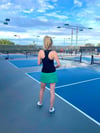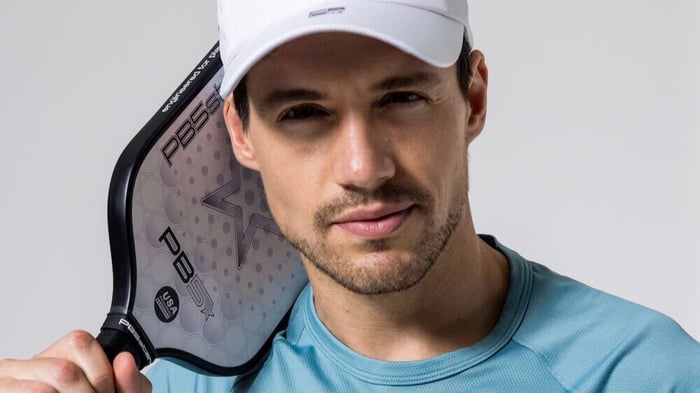Key takeaways:
Recovery is part of how you play better, longer. Smart recovery habits keep your movement clean and your reactions sharp, especially when matches start stacking up.
Real recovery covers more than rest. Stretching, light movement, proper nutrition, and mental resets are all part of bouncing back stronger after tough games.
Injuries usually build quietly, not all at once. Pay attention early. Tightness, sluggish movements, or nagging soreness are signs to adjust, not just push through.
Pickleball moves fast—and it demands even faster reactions from you. Quick sprints, sharp stops, stretched reaches at full speed. Every match pulls more out of your body than you realize in the moment. Over time, that effort adds up, and how well you recover between matches shapes how long you stay strong and sharp on the court.
Recovery keeps your movement clean, your reactions quick, and your body durable through long stretches of matches and training. When recovery falls behind, you feel it—heavier steps, slower decisions, and small aches that don't clear out how they should.
This guide breaks down how to build a pickleball recovery routine that keeps you playing at your best—from small daily habits to full reset days. PB5star designs pickleball gear built to move with you so you can focus on playing hard and recovering smart.
Give your body time and space to rebuild
Hard matches leave your muscles a little tighter, your joints a little more worn, and your reactions a little slower if you don't give yourself enough time to reset. One or two sessions might not feel like much. But over a week or a month, that buildup starts to catch up fast.
You'll notice it in the small stuff first. Tightness that hangs around longer than it should. Movements that feel just a little heavier. That half-second delay when you know what you want to do, but your body isn't quite there yet. The more you skip recovery, the more those small signs pile up—and the harder it gets to shake them off.
How the body rebuilds
After a tough match, your body keeps working. It’s repairing muscles, easing pressure on your joints, and resetting the reflexes that keep you sharp. That quiet work in the background is what helps you show up ready to move again.
Here’s what your body’s handling when you give it time to reset:
Muscle repair: Small muscle fibers tear slightly during intense movement. Recovery is when they rebuild stronger, giving you more durability and strength over time.
Joint reset: Quick stops, lunges, and sudden direction changes put a lot of pressure on your joints. Recovery lets that pressure ease off before it becomes long-term stiffness or pain.
Nervous system reset: Fast reactions burn out your nervous system like muscles get tired. Without enough reset time, you start feeling slower on simple moves, not just tired.
If you skip any part of that rebuild, you start carrying yesterday's fatigue into tomorrow's match. That's when quick reactions turn sluggish, and easy movements start feeling heavier than they should.
What passive recovery looks like
You don't have to shut everything down to recover well. A few steady habits keep your body moving better between heavy sessions:
Full rest days: Real time off—no long matches, no hard training—so your muscles, joints, and reflexes can fully reset.
Good sleep: Deep sleep is when muscle rebuilding and mental reset happen. Short-changing means starting the next day already behind.
Easy movement: Light walks and stretching are enough to stay mobile and keep blood moving without adding more load.
If you're playing or training most days, recovery should always be part of your plan, not something you just squeeze in when you're tired.
Move smart between matches
It's normal to feel drained after a tough match, but sitting still for hours isn't the best way to bounce back. The right kind of easy movement helps clear out tightness, keeps your joints loose, and keeps your system moving toward faster recovery.
Here are a few ways to help your body reset between sessions:
Warm up fully before you play: Spend 5–10 minutes getting your body ready—arm circles, split-step drills, light stretches for your hips and shoulders. It's a simple way to move sharper from your first point.
Cool down right after matches: Walk a few slow laps and stretch out the muscles that took the most work—especially your legs, hips, and shoulders. Cooling down while you're still warm helps your body shift gears instead of tightening up. Staying loose between matches is easier with lightweight, breathable gear like the Core Performance Tee.
Mix light strength work on easy days: Use simple drills like resistance band pulls, lateral lunges, or single-leg balance work. These exercises keep your muscles active without adding more fatigue.
Refuel while you cool down: Get water, electrolytes if needed, and a quick snack with protein and carbs. Recovery starts while you're still on your feet—not two hours later.
Take a quick mental reset: Between games, take a few deep breaths, shake out the tension, and let your body and mind settle before you gear up again.
Staying loose between matches keeps your body ready, your reactions sharp, and your energy steady when the next game picks up speed.
Use recovery tools to support your body
When you're playing hard, recovery tools can help you manage the tightness and soreness that regular rest sometimes doesn't catch. They're quick to use, easy to work into your day and give you another way to stay a step ahead between matches.
A few tools worth keeping close:
Foam rollers: Great for bigger muscle groups—quads, hamstrings, glutes, and back—after long matches or training days. Rolling slow and steady over tight spots helps loosen up stiffness and keeps your body moving better into the next day.
Massage balls: Perfect for smaller spots that tighten up without warning—calves, arches of your feet, shoulders. Rolling them out quickly can save you from bigger problems later.
Compression sleeves or socks: Useful after tournaments, travel days, or anytime your legs and joints feel swollen or heavy. They help keep blood moving and ease pressure without adding more work to your recovery.
Recovery slides: Supportive footwear, like our PB5 Après Sport Slide, can ease pressure on tired feet and joints, giving your body a simple way to recharge between matches.
It doesn't take much. A few minutes with the right tool after a match—or in the evening—can make it easier to show up tomorrow feeling ready to move, not still shaking off yesterday.
Stay ahead of common injuries
Most pickleball injuries don't show up all at once. They build up in the background—small strains that don't clear, joints that feel less stable after a few hard stops, tendons that start nagging during quick cuts.
At first, it's easy to brush it off. You move a little slower, stretch a little longer, and get back out there. But if you're not giving your body time to catch up, all that steady wear starts piling up where you can't shake it off with a few extra minutes of warm-up.
The legs and knees—they're the spots that usually take the hit first. And it's not just soreness you're feeling. Small breakdowns stacking up under the surface if you keep pushing without a real reset.
A few ways to stay ahead of it:
Wear shoes that hold steady: Long matches and quick shifts can wear on your feet fast. A stable, well-cushioned pair like the PB5 Court2 shoes helps you stay steady and cut down on joint fatigue.
Know when it's more than soreness: Feeling tight after a match is one thing. Feeling like you're guarding a joint or dragging a leg is another. If it feels off, pull back and let it reset now—not after it sidelines you.
Recover hard days like they matter: It's not the match you just finished that breaks you down. It's the next one you go into without letting your body rebuild first. Planning real recovery after hard sessions keeps you moving clean instead of chasing injuries later.
If you want to stay healthy and keep playing the way you want to, it starts with paying attention. Give your body time to reset, and don’t be afraid to pull back when something feels off.
Recovery FAQ
Most of what keeps you healthy on court is simple: smart recovery, steady habits, and giving your body time to reset. But once you start playing more often or pushing harder, a few more questions come up. This section clears up some of the stuff you might run into.
What's the best way to deal with soreness that shows up a day later?
That's just delayed soreness—normal after hard matches or when you push into new movements. The best move isn't to sit still. Light walking, easy stretching, and slow mobility work help your body clear it faster. Staying a little active keeps soreness from locking in deeper.
Should you recover differently after a tournament versus a tough practice?
Definitely. After tournaments, your whole system's worn down—not just the muscles you trained. That's when you build in real rest days, deep sleep, and full-body resets. After a tough practice, you can usually get away with active recovery and lighter resets. Bigger stretch of matches? Bigger recovery window.
How do you know if you're not recovering enough—even if you're not injured yet?
It shows up in the little stuff. Your warm-ups take longer. Your first steps feel heavier. You catch yourself thinking slower during points. If those things stick around for a few days instead of clearing up, you're probably playing harder than you're recovering—and it's time to back off a little.
Are ice baths or heat packs worth it?
They can help if you use them right. Ice baths are good after back-to-back heavy days—they cool the system down and manage swelling. Heat works better when you're stiff and trying to get blood moving again. They're good tools but don't replace real recovery like sleep, rest, and smart resets.
Does mental fatigue tie into recovery?
Completely. When your brain's cooked, your body falls right behind it. You react slower, make worse decisions, and your movement gets sloppier without you noticing it. Recovery—especially sleep and light resets—clears mental fog just as much as physical fatigue. Take care of both or you'll feel it fast on the court.
Let your recovery grow with your play
Recovery doesn’t stay the same once you start playing harder. Some weeks, it’s a few extra minutes of stretching. Other times, it’s a full rest day you didn’t think you’d need. Figuring out what your body’s asking for—and adjusting early—is what keeps you moving clean when the matches start stacking up.
You don’t have to build a perfect routine. You just have to stay sharp enough to catch small signs before they turn into big problems. PB5star gear moves with you—through the long sessions, the reset days, and the work it takes to stay ready for the next match.







